Category: Amazon EMR
Amazon EMR Release 4.1.0 – Spark 1.5.0, Hue 3.7.1, HDFS Encryption, Presto, Oozie, Zeppelin, Improved Resizing
My colleagues Jon Fritz and Abhishek Sinha are both Senior Product Managers on the EMR team. They wrote the guest post below to introduce you to the newest release of EMR and to tell you about new EMR cluster resizing functionality.
— Jeff;
Amazon EMR is a managed service that simplifies running and managing distributed data processing frameworks, such as Apache Hadoop and Apache Spark.
Today we are announcing Amazon EMR release 4.1.0, which includes support for Spark 1.5.0, Hue 3.7.1 and HDFS transparent encryption with Hadoop KMS. We are also introducing an intelligent resize feature that allows you to reduce the number of nodes in your cluster with minimal impact to running jobs. Finally, we are also announcing the availability of Presto 0.119, Zeppelin 0.6 (Snapshot) and Oozie 4.0.1 as Sandbox Applications. The EMR Sandbox gives you early access to applications which are still in development for a full General Availability (GA) release.
EMR release 4.1.0 is our first follow-up release to 4.0.0, which brought many new platform improvements around configuration of applications, a new packaging system, standard ports and paths for Hadoop ecosystem applications, and a Quick Create option for clusters in the AWS Management Console.
New Applications and Components in the 4.x Release Series
Amazon EMR provides an easy way to install and configure distributed big data applications in the Hadoop and Spark ecosystems on your cluster when creating clusters from the EMR console, AWS CLI, or using a SDK with the EMR API. In release 4.1.0, we have added support for several new applications:
- Spark 1.5.0 – We included Spark 1.4.1 on EMR release 4.0.0, and we have upgraded the version of Spark to 1.5.0 in this EMR release. Spark 1.5.0 includes a variety of new features and bug fixes, including additional functions for Spark SQL/Dataframes, new algorithms in MLlib, improvements in the Python API for Spark Streaming, support for Parquet 1.7, and preferred locations for dynamically allocated executors. To learn more about Spark in Amazon EMR, click here.
- HUE 3.7.1 – Hadoop User Experience (HUE) is an open source user interface which allows users to more easily develop and run queries and workflows for Hadoop ecosystem applications, view tables in the Hive Metastore, and browse files in Amazon S3 and on-cluster HDFS. Multiple users can login to HUE on an Amazon EMR cluster to query data in Amazon S3 or HDFS using Apache Hive and Pig, create workflows using Oozie, develop and save queries for later use, and visualize query results in the UI. For more information about how to connect to the HUE UI on your cluster, click here.
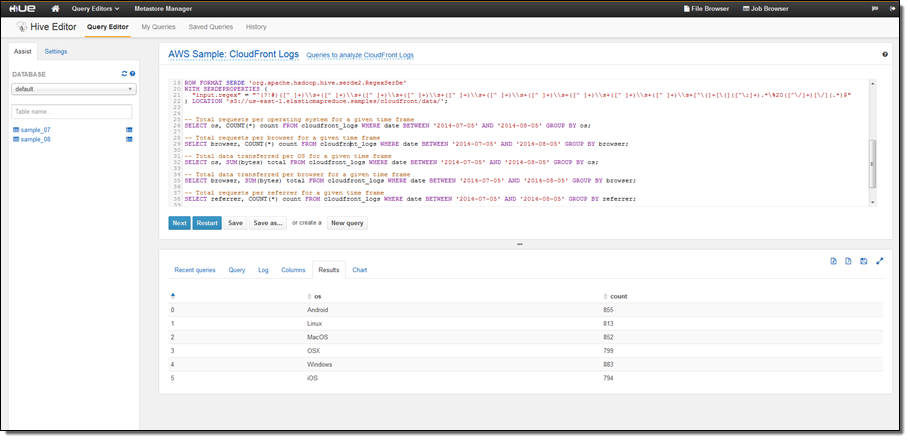
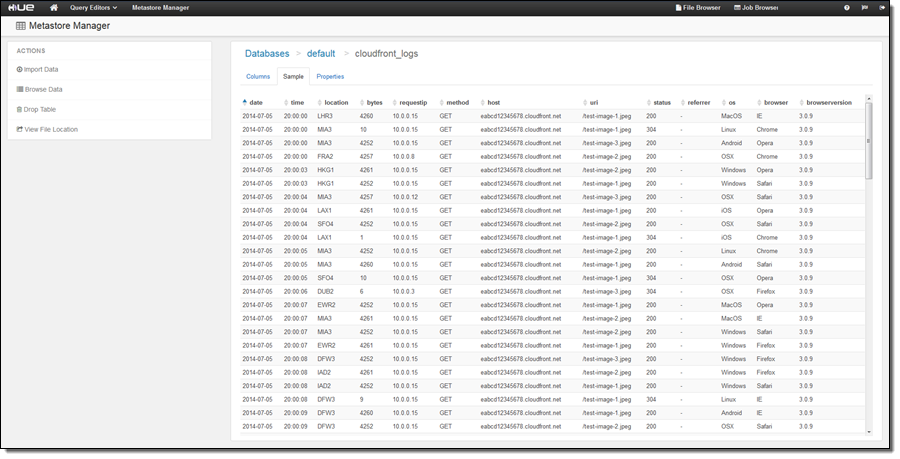
- Hadoop KMS for HDFS Transparent Encryption – The Hadoop Key Management Server (KMS) can supply keys for HDFS Transparent Encryption, and it is installed on the master node of your EMR cluster with HDFS. You can also use a key vendor external to your EMR cluster which utilizes the Hadoop KeyProvider API. Encryption in HDFS is transparent to applications reading from and writing to HDFS, and data is encrypted in in-transit in HDFS because encryption and decryption activities are carried out in the client. Amazon EMR has also included an easy configuration option to programmatically create encrypted HDFS directories when launching clusters. To learn more about using Hadoop KMS with HDFS Transparent Encryption, click here.
Introducing the EMR Sandbox
With the EMR Sandbox, you now have early access to new software for your EMR cluster while those applications are still in development for a full General Availability (GA) release. Previously, bootstrap actions were the only mechanism to install applications not fully supported on EMR. However, you would need to specify a bootstrap action script, the installation was not tightly coupled to an EMR release, and configuration settings were harder to maintain. Instead, applications in the EMR Sandbox are certified to install correctly, configured using a configuration object, and specified directly from the EMR console, CLI, or EMR API using the application name (ApplicationName-Sandbox). Release 4.1.0 has three EMR Sandbox applications:
- Presto 0.119 – Presto is an open-source, distributed SQL query engine designed to query large data sets in one or more heterogeneous data sources, including Amazon S3. Presto is optimized for ad-hoc analysis at interactive speed and supports standard ANSI SQL, including complex queries, aggregations, joins, and window functions. Presto does not use Hadoop MapReduce; instead, it uses a query execution mechanism that processes data in memory and pipelines it across the network between stages. You can interact with Presto using the on-cluster Presto CLI or connect with a supported UI like Airpal, a web-based query execution tool which was open sourced by Airbnb. Airpal has several interesting features such as syntax highlighting, results exported to a CSV for download, query history, saved queries, table finder to search for appropriate tables, and a table explorer to visualize schema of a table and sample the first 1000 rows. To learn more about using Airpal with Presto on Amazon EMR, read the new post, Analyze Data with Presto and Airpal on Amazon EMR on the AWS Big Data Blog. To learn more about Presto on EMR, click here.
- Zeppelin 0.6 (Snapshot) – Zeppelin is an open source GUI which creates interactive and collaborative notebooks for data exploration using Spark. You can use Scala, Python, SQL (using Spark SQL), or HiveQL to manipulate data and quickly visualize results. Zeppelin notebooks can be shared among several users, and visualizations can be published to external dashboards. When executing code or queries in a notebook, you can enable dynamic allocation of Spark executors to programmatically assign resources or change Spark configuration settings (and restart the interpreter) in the Interpreter menu.
- Oozie 4.0.1 – Oozie is a workflow scheduler for Hadoop, where you can create Directed Acyclic Graphs (DAGs) of actions. Also, you can easily trigger your Hadoop workflows by actions or time.
Example Customer Use Cases for Presto on Amazon EMR
Even before Presto was supported as a Sandbox Application, many AWS customers have been using Presto on Amazon EMR, especially for interactive ad hoc queries on large scale data sets in Amazon S3. Here are a few examples:
- Cogo Labs, a startup incubator, operates a platform for marketing analytics and business intelligence. Presto running on Amazon EMR allows any of their 100+ developers and analysts to run SQL queries on over 500 TB of data stored in Amazon S3 for data-exploration, ad-hoc analysis, and reporting.
- Netflix has chosen Presto as their interactive, ANSI-SQL compliant query engine for big data, as Presto scales well, is open source, and integrates with the Hive Metastore and Amazon S3 (the backbone of Netflix’s Big Data Warehouse environment.) Netflix runs Presto on persistent EMR clusters to quickly and flexibly query across their ~25PB S3 data store. Netflix is an active contributor to Presto, and Amazon EMR provides Netflix with the flexibility to run their own build of Presto on Amazon EMR clusters. On average, Netflix runs ~3500 queries per day on their Presto clusters. Learn more about Netflix’s Presto deployment.
- Jampp is a mobile application marketing platform, and they use advertising retargeting techniques to drive engaged users to new applications. Jampp currently uses Presto on EMR to process 40 TB of data each day.
- Kanmu is Japanese startup in the financial services industry and provides offers based on consumers’ credit card usage. Kanmu migrated from Hive to using Presto on Amazon EMR because of Presto’s ability to run exploratory and iterative analytics at interactive speeds, good performance with Amazon S3, and scalability to query large data sets.
- OpenSpan provides automation and intelligence solutions that help bridge people, processes and technology to gain insight into employee productivity, simplify transactions, and engage employees and customers. OpenSpan migrated from HBase to Presto on Amazon EMR with Amazon S3 as a data layer. OpenSpan chose Presto because of its ANSI SQL interface and ability to query data in real-time directly from Amazon S3, which allows them to quickly explore vast amounts of data and rapidly iterate on upcoming data products.
Intelligent Resize Feature Set
In release 4.1.0, we have added an Intelligent Resize feature set so you can now shrink your EMR cluster with minimal impact to running jobs. Additionally, when adding instances to your cluster, EMR can now start utilizing provisioned capacity as soon it becomes available. Previously, EMR would need the entire requested capacity to become available before allowing YARN to send tasks to those nodes. Also, you can now issue a resize request to EMR while a current resize request is being executed (to change the target size of your cluster), or stop a resize operation.
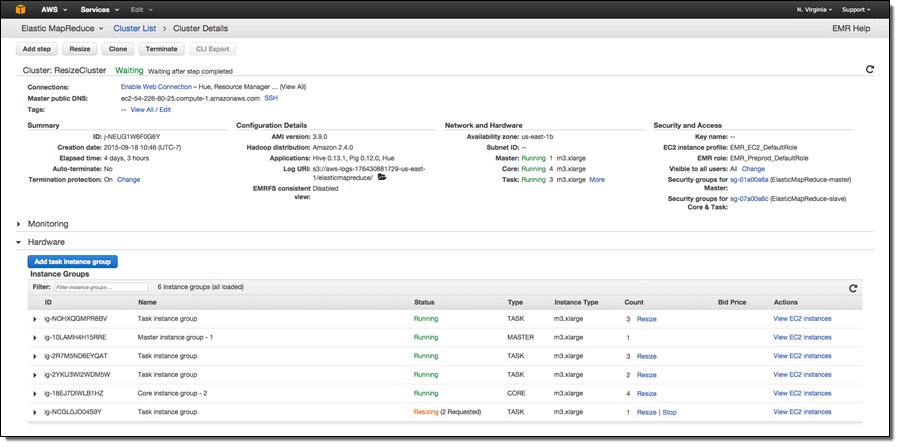
When decreasing the size of your cluster, EMR will programmatically select instances which are not running tasks, or if all instances in the cluster are being utilized, EMR will wait for tasks to complete on a given instance before removing it from the cluster. The default wait time is 1 hour, and this value can be changed. You can also specify a timeout value in seconds by changing the yarn.resourcemanager.decommissioning parameter in /home/hadoop/conf/yarn-site.xml or /etc/hadoop/conf/yarn-site.xml file. EMR will dynamically update the new setting and a resource manager restart is not required. You can set this to arbitrarily large number to ensure that no tasks are killed while shrinking the cluster.
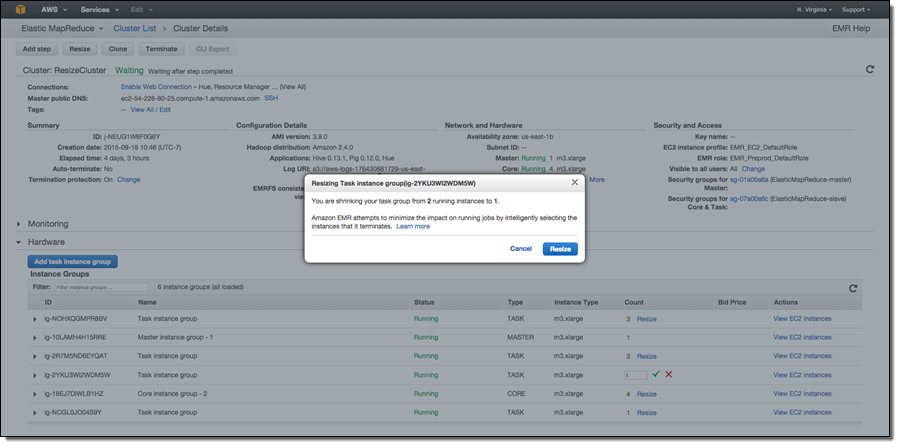
Additionally, Amazon EMR now has support for removing instances in the core group, which store data as a part of HDFS along with running YARN components. When shrinking the number of instances in a cluster’s core group, EMR will gracefully decommission HDFS daemons on the instances. During the decommissioning process, HDFS replicates the blocks on that instance to other active instances to reach the desired replication factor in the cluster (EMR sets the default replication factor to 1 for 1-3 core nodes, the value to 2 for 4-9 core nodes, and the value to 3 for 10+ core nodes). To avoid data loss, EMR will not allow shrinking your core group below the storage required by HDFS to store data on the cluster, and will ensure that the cluster has enough free capacity to successfully replicate blocks from the decommissioned instance to the remaining instances. If the requested instance count is too low to fit existing HDFS data, only a partial number of instances will be decommissioned.
We recommend minimizing HDFS heavy writes before removing nodes from your core group. HDFS replication can slow down due to under-construction blocks and inconsistent replica blocks, which will decrease the performance of the overall resize operation. To learn more about resizing your EMR clusters, click here.
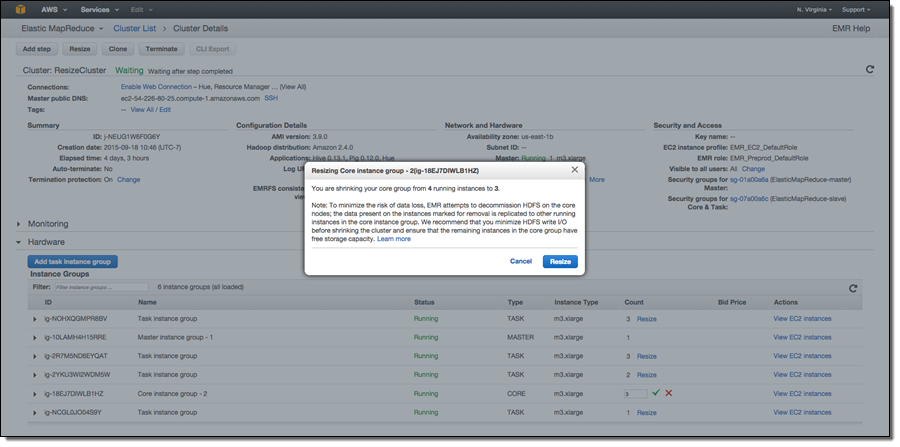
Launch an Amazon EMR Cluster With 4.1.0 Today
To create an EMR cluster with 4.1.0, select release 4.1.0 on the Create Cluster page in the AWS Management Console, or use the release label “emr-4.1.0” when creating your cluster from the AWS CLI or using a SDK with the EMR API.
— Jon Fritz and Abhishek Sinha
New – Apache Spark on Amazon EMR
My colleague Jon Fritz wrote the guest post below to introduce a powerful new feature for Amazon EMR. We updated it on May 16, 2017 in order to describe some new console features and to account for the availability of Spark 2.0.
— Jeff;
 I’m happy to announce that Amazon EMR now supports Apache Spark. Amazon EMR is a web service that makes it easy for you to process and analyze vast amounts of data using applications in the Hadoop ecosystem, including Hive, Pig, HBase, Presto, Impala, and others. We’re delighted to officially add Spark to this list. Although many customers have previously been installing Spark using custom scripts, you can now launch an Amazon EMR cluster with Spark directly from the Amazon EMR Console, CLI, or API.
I’m happy to announce that Amazon EMR now supports Apache Spark. Amazon EMR is a web service that makes it easy for you to process and analyze vast amounts of data using applications in the Hadoop ecosystem, including Hive, Pig, HBase, Presto, Impala, and others. We’re delighted to officially add Spark to this list. Although many customers have previously been installing Spark using custom scripts, you can now launch an Amazon EMR cluster with Spark directly from the Amazon EMR Console, CLI, or API.
Apache Spark: Beyond Hadoop MapReduce
We have seen great customer successes using Hadoop MapReduce for large scale data processing, batch reporting, ad hoc analysis on unstructured data, and machine learning. Apache Spark, a newer distributed processing framework in the Hadoop ecosystem, is also proving to be an enticing engine by increasing job performance and development velocity for certain workloads.
By using a directed acyclic graph (DAG) execution engine, Spark can create a more efficient query plan for data transformations. Also, Spark uses in-memory, fault-tolerant resilient distributed datasets (RDDs), keeping intermediates, inputs, and outputs in memory instead of on disk. These two elements of functionality can result in better performance for certain workloads when compared to Hadoop MapReduce, which will force jobs into a sequential map-reduce framework and incurs an I/O cost from writing intermediates out to disk. Spark’s performance enhancements are particularly applicable for iterative workloads, which are common in machine learning and low-latency querying use cases.
Additionally, Spark natively supports Scala, Python, and Java APIs, and it includes libraries for SQL, popular machine learning algorithms, graph processing, and stream processing. With many tightly integrated development options, it can be easier to create and maintain applications for Spark than to work with the various abstractions wrapped around the Hadoop MapReduce API.
Introducing Spark on Amazon EMR
Today, we are introducing support for Apache Spark in Amazon EMR. You can quickly and easily create scalable, managed Spark clusters on a variety of Amazon Elastic Compute Cloud (EC2) instance types from the Amazon EMR console, AWS Command Line Interface (CLI) or directly using the Amazon EMR API. As an engine running in the Amazon EMR container, Spark can take advantage of Amazon EMR FS (EMRFS) to directly access data in Amazon Simple Storage Service (S3), push logs to Amazon S3, utilize EC2 Spot capacity for lower costs, and can leverage Amazon EMR’s integration with AWS security features such as IAM roles, EC2 security groups, and S3 encryption at rest (server-side and client-side). Even better, there is no additional charge to run Spark in Amazon EMR.
Spark includes Spark SQL for low-latency, interactive SQL queries, MLlib for out-of-the-box scalable, distributed machine learning algorithms, Spark Streaming for building resilient stream processing applications, and GraphX for graph processing. You can also install Ganglia on your Amazon EMR clusters for additional Spark monitoring. You can send workloads to Spark by submitting Spark steps to the EMR Step API for batch jobs, or interacting directly with the Spark API or Spark Shell on the master node of your cluster for interactive workflows.
Example Customer Use Cases
Even before today’s launch, many customers have been working with Spark on Amazon EMR, using bootstrap actions for installation. Here are a few examples:
- The Washington Post is using Spark to power a recommendation engine to show additional content to their readers.
- Yelp, a consumer application that connects users with local businesses, leverages the machine learning libraries included in MLlib with Spark to increase the click-through rates of display advertisements.
- Hearst Corporation uses Spark Streaming to quickly process clickstream data from over 200 web properties. This allows them to create a real-time view of article performance and trending topics.
- Krux uses Spark in its Data Management Platform to process log data stored in Amazon S3 using EMRFS.
Analytics With Spark – A Quick Example
To show an example of how quickly you can start processing data using Spark on Amazon EMR, let’s ask a few questions about flight delays and cancellations for domestic flights in the US.
The Department of Transportation has a public data set outlining flight information since 1987. I downloaded it, converted the file format from CSV to the columnar Parquet format (for better performance), and uploaded it to a public, read-only S3 bucket (s3://us-east-1.elasticmapreduce.samples/flightdata/input). The data set is around 4 GB compressed (79 GB uncompressed) and contains 162,212,419 rows, so it makes sense to use a distributed framework like Spark for querying. Specifically, I would like to know the 10 airports with the most departures, the most flight delays over 15 minutes, the most flight delays over 60 minutes, the and most flight cancellations. I also want to know the number of flight cancellations by yearly quarter, and the 10 most popular flight routes.
I translated these questions into SQL queries, and wrote a Spark application in Scala to run these queries. You can download the Scala code from s3://us-east-1.elasticmapreduce.samples/flightdata/sparkapp/FlightSample.scala; I have an excerpt below:
val df = session.read.parquet("s3://us-east-1.elasticmapreduce.samples/flightdata/input/")
//Parquet files can also be registered as tables and then used in SQL statements.
df.createOrReplaceTempView("flights")
//Top 10 airports with the most departures since 2000
val topDepartures = session.sql("SELECT origin, count(*) AS total_departures \
FROM flights WHERE year >= '2000' \
GROUP BY origin \
ORDER BY total_departures DESC LIMIT 10")
Note that the application creates a table “flights” which is an in-memory DataFrame, and each SQL query uses that table to reduce the I/O cost for the query. Also, Spark in EMR uses EMRFS to directly access data in S3 without needing to copy it into HDFS first. Notice the input dataset and output location in S3. I compiled the application into a JAR, and you can download it at https://s3.amazonaws.com/us-east-1.elasticmapreduce.samples/flightdata/sparkapp/flightsample-1.0.jar.
Let’s launch a three node m3.xlarge Amazon EMR cluster with Spark to execute this application. Make sure you are launching your cluster in the US East region, because the sample dataset for this example is located in that region. Go to the Create Cluster – Advanced Options page in the Amazon EMR console. Scroll down to the Software Configuration section to add Spark as an application:
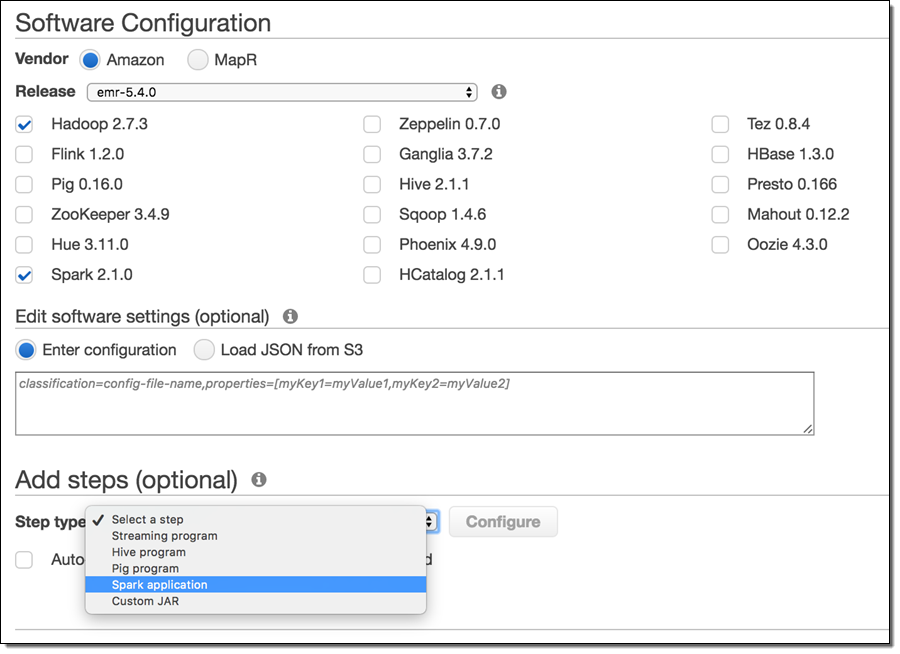
By default, Amazon EMR configures Spark to use dynamic allocation of executors and sets the default RAM and cores per executor based on the Core Group instance type. However, you can always overwrite these settings at runtime by passing extra parameters to the actual spark-submit command.
Next, scroll to the Steps section near the bottom of the page to add your Spark job. Add a Spark application step:
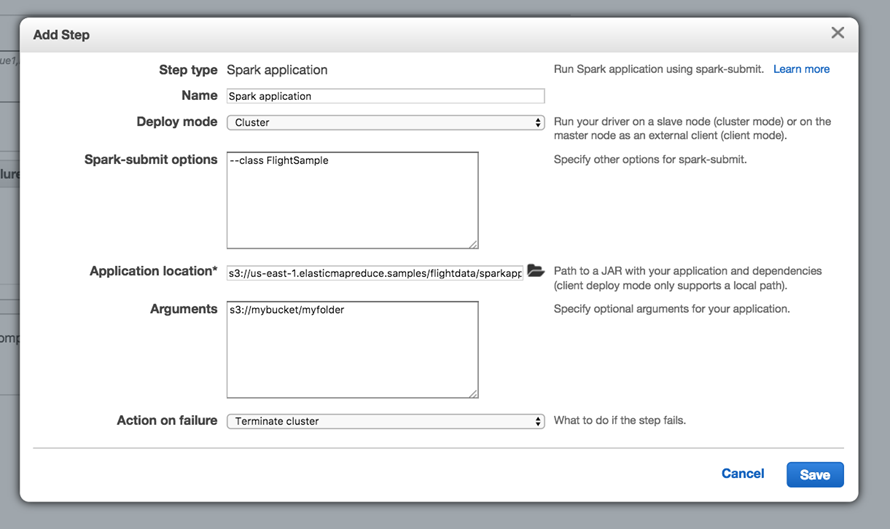
In the modal, select Cluster for Deploy Mode. For Application location, enter s3://us-east-1.elasticmapreduce.samples/flightdata/sparkapp/flightsample-1.0.jar. For Arguments, add an S3 path to a bucket in your account where you would like Spark to write the output. And, change Action on failure to Terminate cluster. Then click Add.
Then, check the Auto-terminate cluster after the last step is completed option at the bottom of the page, so the cluster will automatically shut down once your Spark application is finished running.
Click Next to advance to Step 2 in the cluster creation wizard. Review the hardware selection for your cluster. By default, you should see 1 master node and 2 core nodes specified with the m3.xlarge instance type. We will use this instance type and cluster size for this demo.
Click Next to advance to Step 3. Uncheck the Logging and Termination Protection options under General Options. Click Next to advance to Step 4 (there are no settings to change on this page), and then continue and click Create Cluster.
Amazon EMR will launch the cluster, run your Spark application, and terminate the cluster when the job is complete. You can monitor progress of your job from the Cluster Details page in the EMR console. Once the job is complete, you can view the output of the queries in the S3 bucket you indicated. I won’t ruin the surprise of the results, either – but definitely bring something to read if you’re flying from Chicago O’Hare.
Launch an Amazon EMR Cluster with Spark Today!
For more information about Spark on Amazon EMR, visit the Spark on Amazon EMR page.
— Jon Fritz, Senior Product Manager
New Whitepaper: Amazon Elastic MapReduce (EMR) Best Practices
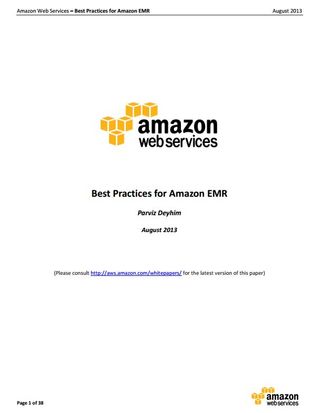
When analyzing massive amounts of data, the issue encompasses more challenges than simply data processing and computing. One has to make several decisions regarding how to collect and aggregate data, how to move data or point the data source to the cloud, how to compress the data and finally how to process the data faster and more cost-effectively.
In that regard, we are very excited to release the Best Practices For Amazon EMR whitepaper today. This whitepaper highlights the best practices of moving data to AWS, collecting, aggregating and compressing the data, and discusses common architectural patterns for setting up and configuring Amazon EMR clusters for faster processing. We also discuss several performance and cost optimization techniques so you can process and analyze massive amounts of data at high throughput and low cost in a reliable manner.
As always we would love to get your feedback. Please feel free to use the comments below to leave feedback so we can improve our products, features and documentation. Thanks!
Amazon Elastic MapReduce Updates
We’ve updated Amazon Elastic MapReduce with support for the latest and greatest versions of the following components:
The new version of Hadoop includes the following enhancements:
- MultipleInputs class for reading multiple types of data.
- MultipleOutputs class for writing multiple types of data.
- ChainMapper and ChainReducer which allows users to perform M+RM* within one Hadoop job. Previously you could only run one mapper and one reducer per job.
- Ability to skip bad records that deterministically kill your process. This allows you to complete a job even if a few records cause your process to fail.
- JVM reuse across task boundaries. This should increase performance when processing small files.
- New MapReduce API. This introduces a new Context object that will allow the API to evolve without causing backwards incompatible changes. This should allow customers to write jobs that will maintain compatibility beyond Hadoop 1.0.
- Support for bzip2 compression
If you are thinking about implementing a large-scale data processing system on AWS you may find the Razorfish case study of interest. They use Elastic MapReduce to analyze very large click-stream datasets without having to invest in their own infrastructure. The Elastic MapReduce Tutorial and the Elastic MapReduce Developer Guide will teach you what you need to know to do this type of work yourself.
–Jeff;